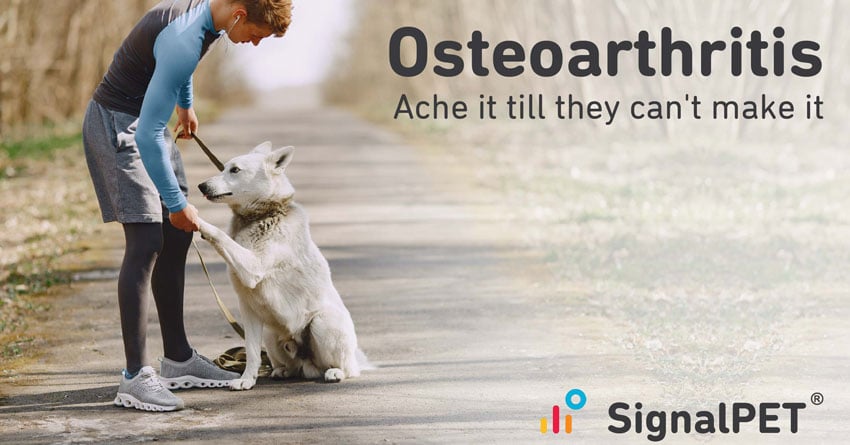Canine Osteoarthritis - Ache it until they can't make it
Published by SignalPET on February 04, 2021

Canine osteoarthritis (OA) is a very common problem that affects between one-third to one-half of all canines at some point in their lives.
What is Osteoarthritis?
Described as a common clinical and pathological end-point from a range of joint disorders, osteoarthritis ultimately leads to structural and functional decline of the joint(s) with associated lameness/pain and limb dysfunction. While a majority of cases occur secondary to developmental orthopedic disease—namely, cranial cruciate rupture, hip/elbow dysplasia, patella luxation, and OCD—a small subset occurs with no primary cause and may be related to genetics and age. Bodyweight, gender, diet, and exercise are other contributing factors found to be related.
While severe disease is generally easy to diagnose, osteoarthritis can be challenging to detect during the early stages. The challenge is often compounded with some pets being more stoic than others, hiding their pain and suffering until it becomes too severe to mask. Most owners are unaware that their pets have OA, which has led to it being referred to as “silent pain” or those affected as “suffering in silence” until the pain is harder to hide. Since early detection may slow its progression and improve quality of life for longer, early detection and appropriate management during the routine examination may be one of the most important roles veterinarians have that may significantly improve the quality of the human-animal bond, for longer.
SignalPET is very excited to announce its release of two new tests, Elbow and Stifle Osteoarthritis, in hopes that you keep your patients walking well - well into their senior years.
Included below is a brief summary of clinical signs, diagnosis, and treatment options for osteoarthritis.
4 Early Warning Signs :
- Change in gait: Stiffness and difficulty getting up (especially in cold weather), lameness, and other changes in gait (eg “bunny-hopping”)
- Weight gain and/or muscle atrophy: Weight gain is linked to owners feeding the same amount throughout the different phases of their pet’s life despite a decrease in activity on account of discomfort/pain, while muscle atrophy is due to the decreased use of associated muscle groups.
- Irritability and/or other signs of pain: Licking is often overlooked as a sign of pain and often brushed off as “allergies.” Any form of unprovoked or unusual growling or hissing, or snapping during handling, should warrant a full investigation.
- Changes in behavior: If your pet is no longer willing to climb stairs or jump on the couch/bed, but instead settles for the floor. The desire for solitude, particularly in search of warm and soft places to sleep.
Diagnosis:
Often a combination of a thorough history, full clinical examination (paying attention to joint manipulation/swelling and muscle atrophy), and diagnostic imaging.
While routine radiography may have its limitations, if used concurrently and effectively with a thorough history and physical examination, it can be a cost-effective first-line diagnostic tool.
Ideolepsis (state of being so convinced of one diagnosis or conclusion that all other rational alternatives are discarded) often means that OA is disregarded/overlooked, even after the initial crisis/presenting complaint is rectified.
Treatment:
Unfortunately, there is no cure for Osteoarthritis. Treatment is aimed at alleviating pain and discomfort, in addition to delaying the progression of the disease. Treatment recommendations for OA are multimodal and include:
-
Pain Control: Pain control is the mainstay of osteoarthritis treatment. The most commonly used pain control medications are Non-Steroidal Anti-Inflammatory (NSAID) such as Carprofen and Meloxicam, while adjunctive pain medications (Gabapentin, Tramadol, acupuncture, CBD oil) can also be considered, but overall there is a lack of studies that prove their efficacy.
- Weight Control: All patients affected by OA will benefit from weight reduction. A reduction in as little as 6% body mass has shown to have a significant impact. Weight loss is by far the most critical aspect of OA management and significantly slows the progression of the disease. Encourage and engage your clients to assess their pet’s conditions by assessing the ribs (ideally, you do not want to see the ribs, but want to be able to feel them with relative ease during palpation), a nice tucked up belly, and hour-glass appearance when viewed from above (not a “watermelon” silhouette!)
- Activity Modification: Avoid high impact activities. Instead, controlled, low impact activities (walks, physiotherapy, aqua therapy) should be used to maintain muscle mass and promote joint stability.
- Rehabilitation: Passive range of motion exercises and aqua therapy help to maintain muscle mass and joint stability and improve exercise endurance. Acupuncture and laser therapy are alternative rehabilitation modalities used, but lack studies to prove their efficacy.
- Joint Supplements: Glucosamine, Chondroitin, green-lipped mussel extract, and omega-3-fatty acid supplementation are the most commonly prescribed, and help to improve function, reduce inflammation, and slow the progression of joint damage.
- Diet: Age-appropriate, joint-specific diets have a natural anti-inflammatory action and maintain healthy joints and growth.
- Surgery: Surgical intervention can also play an important role in the management of osteoarthritis in dogs and cats. While most beneficial in the early stage of the disease, to try and modify the development of the disease, or in late joint disease as an attempt to salvage and restore some pain-free function when non-surgical management is failing to control pain or the joint is mechanically non-functional.
